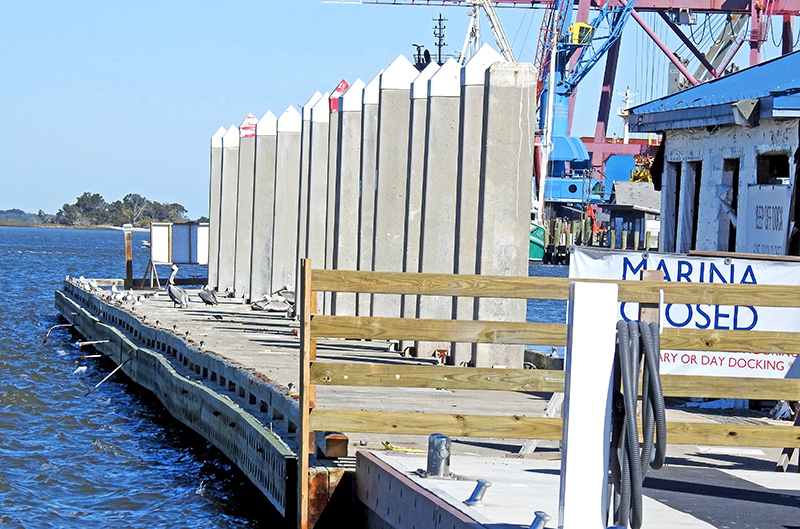As we usher in the Christmas holiday season each year when the calendar turns from November to December, we also welcome the end of Atlantic hurricane season.
As noted by Nassau County Emergency Management on the very last day of hurricane season, Nov. 30, 2023 (via a Facebook post), “Who’s celebrating?”
When a hurricane season closes, especially another uneventful one for local area residents, we certainly can give thanks that once again, here around the Florida-Georgia border, we made it through another year, avoiding the unthinkable. This local region dodged the extensive destruction and loss many other communities end up suffering when falling victim to the power of Mother Nature.
Elsewhere, some Floridians did experience a major hurricane landfall in their region during the 2023 Atlantic hurricane season. CAT 3 Hurricane Idalia made landfall on the Gulf side of the state in the Big Bend area on August 30, 2023.
“2023 Atlantic hurricane season ranks 4th for most-named storms in a year” Says NOAA
According to an NOAA news release, the season was summed up:
“The Atlantic basin saw 20 named storms in 2023, which ranks fourth for the most-named storms in a year since 1950. Seven storms were hurricanes and three intensified to major hurricanes. An average season has 14 named storms, seven hurricanes and three major hurricanes. “
SOURCE: NOAA, November 28, 2023
With the season now concluded, Idalia turned out to be the only hurricane to make landfall in the U.S. during the Atlantic hurricane season of 2023. For Amelia Island residents and those living elsewhere on the mainland in Nassau County, FL, Idalia’s very minor local impacts were as a weaker tropical storm. Once again, Amelia Island and Nassau County in northeast Florida experienced a favorable outcome with yet another hurricane season tucked behind us.
This year, notably, Idalia’s landfall in the Big Bend as a CAT 3 was an area of Florida where historically hurricanes are more unusual. Idalia became “the strongest hurricane to hit the region in more than 125 years,” according to NOAA.
When was the last time a major hurricane (CAT 3 or higher) made landfall in the vicinity of the Florida-Georgia border? It was 125 years ago, when the Georgia Hurricane of 1898 made direct landfall on Amelia Island’s next-door neighbor, Cumberland Island, GA. The strongest, most damaging hurricane impacting the city of Fernandina appears to be this one. In modern times, hurricane experts have completed a re-analysis of historic data from hurricanes of long ago. The October Georgia Hurricane of 1898 was designated a CAT 4 that made landfall on Cumberland Island, GA with estimated winds of 135 MPH. The hurricane also brought massive storm surge. With Amelia Island’s close proximity to the bull’s-eye, historic newspaper reports describe downtown Fernandina as being destroyed. One example, Fernandina’s “old” train depot at the foot of Centre Street is circa 1899 because its predecessor was destroyed in the 1898 hurricane.

A LOOK BACK AT LAST EIGHT HURRICANE SEASONS (2016 – 2023)
In recent years, local hurricane evacuations have become all too familiar here at the Florida-Georgia border.
List of Hurricanes Triggering Five Amelia Island/Nassau County, Florida Emergency Evacuations During Last Eight Hurricane Seasons (2016 – 2023) **
- Matthew (October 2016)
- Irma (September 2017)
- Dorian (September 2019)
- Ian (September 2022)
- Nicole (November 2022)
Glimpse back at some images taken around Amelia Island either just before or right after the hurricanes listed above in the photo gallery below.
























This northeast Florida coastal county at the Georgia border has now experienced five hurricane evacuations in a relatively short time span during the last eight seasons (2016 to 2023).
Fortunately for local residents, the outcomes were far better than what could have been, since storm tracks had changed favorably by the time they reached the local region. The worst potential wind, the highest storm surge scenarios, and the top estimates of rainfall never materialized here. Of these five storms, Matthew in 2016 caused the most damage to the city of Fernandina Beach, destroying docks and piers, including severe damage to the city’s downtown marina and the Fort Clinch fishing pier, pictured below before Hurricane Matthew (sadly, the pier no longer exists).

The pier at Fort Clinch State Park was 2,409 feet long — 864 feet longer than the state’s next longest — but was removed in 2017 after sustaining hurricane damage the prior year. It was a state-level decision, and unfortunately the pier has not been replaced. (See past article, The Vanishing Pier At Fort Clinch published in 2017).
Two Amelia Island/Nassau Evacuations In 2022
Last year in Nassau County, Florida, two evacuation directives were issued during a single hurricane season in 2022 — first for Ian in late September, and then Nicole in November. The two evacuations issued by Nassau Emergency Management in 2022 impacted a large portion of Amelia Island plus some mainland areas of Nassau County.
Nassau County Emergency Evacuation Zones Map

Looking back, last year’s evacuation directives were for Nassau County zones, “A” and “D” for both Ian and Nicole. Ian was the first hurricane to potentially threaten Nassau County since Hurricane Dorian in 2019. In between these two hurricanes, local Nassau County evacuations zones changed. For example, the entire area of Amelia Island had been evacuation zone “A” during Dorian in year 2019 (and during Irma and Matthew, as well). By hurricane season 2022, however, this changed, with the creation of three Amelia Island evacuation zones — A, B, and C.
Remember The “Sweet 16”?
Before these more recent active tropical cyclone years, a time when evacuations have become more the norm than a deviation, was a much quieter span of time. We’ll call it a “sweet 16” hurricane seasons without an Amelia Island evacuation mandate. Those who’ve lived locally long enough will remember this quiet time period, after Hurricane Floyd in 1999, the sixteen hurricane seasons from 2000 through 2015.

September 1999’s Hurricane Floyd (NOAA image above), triggered widespread evacuations in Florida from Miami to Fernandina Beach (over a million people fled). Floyd became notorious for the massive gridlock that unfolded, with traffic stopped or barely crawling on major evacuation routes.
As for the entire Sunshine State, some Floridians might recall the hurricane “dry spell,” when Florida went through a decade of hurricane-free bliss in the years 2006 through 2015. It was a time when zero hurricanes made landfall in the state for these ten consecutive seasons, a remarkable stretch. Wouldn’t it be nice if we could experience another lengthy “dry spell”?
September 1964 — Hurricane Dora
The last time a hurricane actually made landfall anywhere near Nassau County, FL was in September 1964. Hurricane Dora, a CAT 2, made landfall in St. Augustine (about an hour’s drive south of Amelia Island). September’s Hurricane Dora in 1964 “destroyed fifty homes in Nassau County in part due to erosion below the structures,” according to OneNassau.com. A documentary made in recent times describes Dora as “the storm that brought the First Coast to its knees.”

MAY 2024 — Next NOAA Outlook Scheduled
As time marches on and another year passes, the next hurricane outlook for the 2024 Atlantic hurricane season will be issued by NOAA’s Climate Prediction Center in May 2024, in advance of the official start of the next hurricane season that begins on June 1, 2024.
The Atlantic hurricane season officially begins on June 1st and ends each year on Nov. 30th. However, weather experts warn that storms can form anytime.
** Footnote — More About Idalia & Lack of Local Impacts
Locally, Nassau County, Florida Emergency Management issued a very limited evacuation order due to potential impact from tropical storm Idalia (that took effect at 8 a.m. on August 29, 2023), for those considered the most susceptible during storms — power-dependent special needs individuals, flood-prone structures, vulnerable structures, and mobile homes.” However, this was not a more widespread “zone” evacuation impacting much larger numbers of residents, like the five hurricane evacuations listed above, so Idalia is not included on the list.
Idalia – Nassau County & City Damage Assessments
The day after tropical storm Idalia, Nassau County Emergency Management announced via Facebook, “Preliminary damage and debris assessments by Nassau County’s emergency responders indicate minor impacts to the area caused by wind.” Basically, residents had yard cleanup in the way of raking leaves and picking up branches from windy conditions, but Idalia felt more like a mild Nor’easter.
Separately, in the city of Fernandina Beach, the interim city manager, Charlie George, described the fortunate outcome at the Sept. 5, 2023 city commission meeting:
“As everyone knows we dodged a bullet last week with Hurricane Idalia… We were fortunate we didn’t have any flooding. Corps of Engineers came out after the storm last Friday and looked, said the beach didn’t’ get damaged.”
Local Information Resources
For local information during hurricane season, visit the Nassau County, Florida Emergency Management website. Also download the Nassau County Citizen’s Disaster Guide. Sign up for Nassau County’s emergency alerts send via text to mobile phones
Related Content — Previous articles about local impacts from hurricanes:
- Beach Erosion — A Look Back At Ian And Nicole (Hurricane Season 2022)
- Hurricane Ian Inflicts Damage to Fernandina Harbor Marina
- State Awards $922,016 To Nassau County, FL For Hurricane Beach Erosion (Jan. 2023)
- So Far, So Good: Slow Start To Hurricane Season 2022, But Peak Time Is September
- Hurricane Dorian Prompts Mandatory Evacuation of Amelia Island (2019)
- The Vanishing Pier At Fort Clinch (2017)
- Up To 10 Years To Replace Fort Clinch Pier? (2017)
- Scenes of Fort Clinch After Hurricane Irma (2017)
- Cumberland Island National Seashore Closed Since Hurricane Irma (2017)
- The October Hurricane Not Soon To Be Forgotten (2016)
- Feeling Fortunate In Fernandina (2016)
- Less Is More: Fernandina On List Of Least Hurricane Risk (2015)
